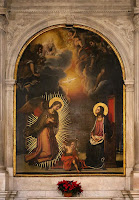Mannerist painter’s masterpiece was inspired by his mistress
 |
| A self-portrait of Allori from about 1606, which is in the Uffizi Gallery |
Allori was a painter of the late Florentine Mannerist school who specialised in portraits and religious subjects. He is well regarded by experts because of the delicacy and technical perfection of his work. His skill was demonstrated by some copies he made of Correggio’s works, which for a time were thought to be duplicates that had been painted by Correggio himself.
The artist was extremely fastidious about his work, which limited the number of paintings he executed, but there are still fine examples of his art to be seen in Florence.
He received his first lessons in painting from his father, Alessandro Allori, who had many distinguished pupils, including the painter known as Cigoli, whose real name was Lodovico Cardi.
Cristofano became dissatisfied with the anatomical drawing and use of colour that distinguished the work of his father and went into the studio of Gregorio Pagani, who was one of the leading artists of the late Florentine school. Pagani aimed to combine the Florentine attention to drawing with the use of rich colours, which was the style of the Venetian painters of the period.
It is thought Cristofano Allori may have also worked under the guidance of his father’s former pupil, Cigoli, for a time.
 |
| Judith with the Head of Holofernes is striking for its vivid colours |
His most famous painting, both in his own lifetime and still today, is his Judith with the Head of Holofernes. According to a biography of the artist by Filippo Baldinucci, written in the late 17th century, the model for Judith was Cristofano’s mistress, Maria de Giovanni Mazzafirra, a beautiful woman known as La Mazzafirra, who is also represented in his painting, Magdalene.
The head of Holofernes that Judith is carrying is thought to be a self portrait by the artist, and the maid shown in the picture as behind Judith is believed to be the mother of La Mazzafirra. Baldinucci claims Allori painted this work partly as an autobiographical account of his love affair with La Mazzafirra, which ended badly.
The account of Judith beheading Holofernes is an apocryphal story from the Book of Judith, which existed in the Greek translation of Hebrew scriptures that formed the basis of the Old Testament.
The story was that the Assyrian king Nebuchadnezzar sent his general Holofernes to besiege the Jewish city of Bethulia. Judith, who was a beautiful young widow, decided to save her people by slaying Holofernes herself and she put on her finest clothes and set out to seduce him. After Holofernes had drunk enough wine to become intoxicated, she decapitated him with her own sword, winning a decisive victory for the Israelites.
 |
| Allori's Annunciation in Pistoia Cathedral |
The best-known version, painted in 1620, is in Palazzo Pitti in Florence. There are also copies of the painting by other artists working in the same studio, including one in the Vatican Pinacoteca and one in a gallery in Berlin.
Other notable paintings by Allori include a portrait of two of the Medici children, Francesco, and Caterina, painted in 1598, and a painting of the Annunciation, which is in Pistoia Cathedral.
He died in 1621 at the age of 43.
 |
| The Palazzo Pitti, as seen from the Boboli Gardens, has been the home of several families |
Travel tip:
Palazzo Pitti in Florence, was originally built for the banker Luca Pitti in 1457 in the centre of Florence, to try to outshine the Medici family. Cosimo I de' Medici later bought it from Pitti’s bankrupt heirs and made it the main Medici residence in 1550. Today visitors can look round the richly decorated rooms and see treasures from the Medici collections. A version of Judith with the Head of Holofernes painted by Cristofano Allori is in Pitti Palace’s Palatine Gallery collection. After the decline of the Medici, the palace housed the courts of two other great European dynasties: the House of Habsburg-Lorraine from 1737 and the House of Savoy, from 1865.
 |
| The Romanesque-style facade of the Cattedrale di San Zeno, the Duomo of Pistoia |
Pistoia is a medieval walled city in Tuscany to the north west of Florence. The Cathedral of Saint Zeno, or the Duomo of Pistoia, is in the Piazza del Duomo in the centre of the city. Originally built in the 10th century, the cathedral has a façade in Romanesque style. As well as his Annuciation, the cathedral has a Resurrection by Cristofano Allori, which can be found in the apse of the Presbytery. Also set around the Piazza del Duomo are the octagonal Battistero di San Giovanni in Corte, and the Palazzo dei Vescovi, an 11th-century palace that was bought and restored by the Cassa di Risparmio di Pistoia, a regional bank, in the late 20th century and how houses a museum complex.
Also on this day:
1473: The birth of Renaissance sculptor Bartolommeo Bandinelli
1797: The Treaty of Campio Formio hands Venice to Austria
1810: The birth of tenor Giovanni Matteo Mario
1907: The founding of Atalanta Bergamasco Calcio
No comments:
Post a Comment